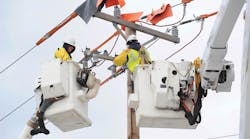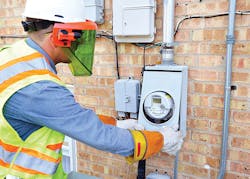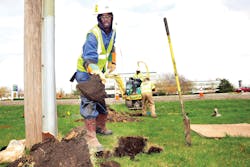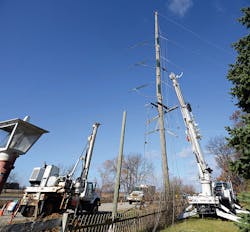Commonwealth Edison’s Year of Record Reliability
Utilities are in the midst of a massive transformation driven by the proliferation of distributed energy resources, creation of new business and regulatory models, dependence on interconnected industries and, lastly but perhaps most notably, evolution of customer expectations. Electric customers have come to depend on energy for every aspect of their lives, from work and family to fun and play. Modern society relies on electricity, and customers have come to expect power all the time, without any interruptions, which greatly heightens the necessity for enhanced reliability. To further the challenge of meeting these amplified demands and expectations, weather can be more volatile because of climate change as well as the increased frequency and severity of extreme weather events across the U.S.
Commonwealth Edison (ComEd) envisions a future as a premiere service organization. Meeting these intensified demands and expectations while mitigating weather concerns is not a question but a necessity. In 2011, ComEd’s aging infrastructure was decades old in certain areas, and the basic structure had remained unchanged over the past 100-plus years. As a result, the grid’s ability to meet the changing landscape was brought into question. The utility took proactive measures to modernize its grid through the Energy Infrastructure Modernization Act (EIMA). Passed into law in 2011, EIMA enabled ComEd to invest US$2.6 billion to modernize its grid and install smart technology.
More specifically, ComEd made an investment of $1.3 billion to improve reliability with programs focused on underground residential distribution (URD) cable, mainline underground cable, manholes, wood poles, storm hardening and training centers. Another $1.3 billion was invested in smart technology — smart switches, smart substations and smart meters — which resulted in the installation of a mesh communications network. Infrastructure investments and significant workforce efforts culminated in record reliability in 2016 as ComEd realized significant benefits, delivering on heightened customer demands while dealing with an increase in weather challenges.
Beyond the Numbers
ComEd’s electric system experienced superior reliability to that of comparable utilities in 2016:
• 34% reduction in the frequency of customer interruptions since 2012
• 0.62 system average interruption frequency index (SAIFI), excluding major event days (MEDs) and planned outages
• All-time low in the number of customers experiencing multiple interruptions (CEMI)
• More than 1.8 million avoided customer interruptions
• 99.98% average service availability index, a commonly used reliability index.
Beyond just the numbers, ComEd’s customers appreciate the improved reliability, as customer satisfaction was the utility’s best on record in 2016.
The utility achieved record reliability in 2016 because of a significant amount of investment and an efficient on-time work schedule completed over the last five years through the EIMA program. EIMA consisted of two major components — grid modernization and smart technology — each of which has materialized into reliability benefits for the overall system.
Enabling Reliability
The modernization of ComEd’s electric infrastructure included the assessment, treatment and replacement of electric cable, underground manholes, wood poles and storm-hardening programs, all of which have decreased the frequency of customer outages and had impacts on reliability:
• The URD cable assessment, treatment and replacement program aims to remediate poor-performing URD cable by proactively evaluating the infrastructure, and then injecting it or replacing it. Over the course of the program, nearly 3500 miles (5633 km) of cable have been replaced, resulting in a decrease in URD cable faults by 27%.
• The mainline cable assessment and replacement program consists of replacing cable, conducting manhole assessments and refurbishing manholes. This enables the utility to identify issues with equipment, such as leaking cables or joint malfunctions. Over the course of the program, more than 4800 primary cable defects have been identified and 34,000 manholes assessed. While work is ongoing to mitigate any issues, mainline cable faults have decreased by 36% over the last five years.
• The wood pole inspection, treatment and replacement program is designed to inspect, treat and replace wood poles. Over the course of the program, approximately 735,000 poles have been inspected, 12,500 poles replaced and 8000 poles reinforced. Outages due to broken poles are down 10% over the last five years.
• Storm-hardening programs increase the resilience of the electric distribution system and reduce the system’s susceptibility to storm-related damage, including high-wind thunderstorms and precipitation-related events. This program involves a variety of engineered solutions, such as enhanced vegetation management, overhead to underground conversions, cable relocation and spacer cable installations. These programs have resulted in vegetation-related outages being down 39% over the last five years and the average number of customer interruptions per storm being down 37% during that time frame.
• Two new state-of-the-art training centers in Illinois — one in Chicago and one in Rockford — were constructed to educate and train the workforce of the future, further developing skills to provide reliable and affordable power to all ComEd customers. These facilities include substation and meter areas, indoor pole yards, lead-splicing bays for underground cable and manhole training areas. The training centers also serve as auxiliary storm centers to expand and support ComEd’s coordination and response time during significant events.
The modernization of ComEd’s grid has been essential to enhanced reliability, but it is not the only driver. The installation of smart technology also has proved beneficial.
Enhancing Reliability
The installation of smart technology included smart switches, smart substations and smart meters. This has provided greater insights into system operations while enabling enhanced control through digital technology:
• The distribution automation program focuses on the installation of smart switches that enable power to be rerouted during outages. More than 2600 of these devices have been installed over the last five years, helping to avoid 1.4 million customer interruptions in 2016 alone. These devices also have reduced the number of customers per lockout by 22%; a lockout occurs when a feeder loses power because of a fault, resulting in a sustained outage.
• The smart substation program consists of enhanced digital monitoring and control devices at 10 substations, effectively creating smart substations that enable operators to maintain a better view of equipment conditions. As a result, ComEd can proactively address substation equipment likely to fail due to age, preventing potential issues before they affect customers.
• Advanced metering infrastructure (AMI), or smart meters, wirelessly transmit usage, consumption and status data through a mesh communications network back to ComEd. These meters have a last-gasp feature that activates when a meter loses power, sending a final signal back to the central offices and alerting ComEd of customer outages. With real-time outage information on customers, ComEd can send field crews to address issues without waiting on the customer to call in and inform the utility of the power outage.
With overall greater insights into system operations, more than 320,000 truck rolls were avoided in 2016, including nearly 37,000 because of customer trouble reports. This enabled crews to work on higher-priority issues in the field. Furthermore, this work has reduced, by 80%, the number of lengthy outages caused by storms since pre-EIMA.
The comprehensive nature of EIMA enabled ComEd to address aging infrastructure and invest in smart technology. Modernizing the grid was just the start, as record reliability has followed and several key metrics are the best ComEd has ever had.
Record Reliability
The investment through EIMA has strengthened ComEd’s electric infrastructure considerably, reducing interruptions from cable faults, equipment failures and storms, or avoiding interruptions altogether. This has resulted in overall record reliability for performance metrics. Examining the frequency of customer interruptions, ComEd outperformed all utilities with similar characteristics, ending 2016 with an IEEE 2.5 Beta SAIFI of 0.75, including MEDs, and 0.62, excluding MEDs and planned outages, which correlate to reductions of 44% and 34%, respectively, when compared to pre-EIMA statistics.
Furthermore, the IEEE 2.5 Beta system average interruption duration index (SAIDI) of 54 minutes, including MEDs, and 87 minutes, excluding MEDs and planned outages, are down 81% and 68%, respectively, when compared to pre-numbers.
In addition, more than 3.2 million customers experienced zero outages or one outage in 2016, and while some customers did experience more than one interruption, the number of those customers was the lowest ever. CEMI of 4+ and 10+, CEMI4 and CEMI10, are down 96% and 73%, respectively, compared to pre-EIMA levels.
The utility is not the only entity that is noticing a difference, as customer satisfaction is considerably higher than pre-EIMA years. In terms of overall customer satisfaction before EIMA, ComEd was the lowest-ranked utility in the Midwest large segment in J.D. Power’s Electric Utility Residential Customer Satisfaction Study. The utility ranked last in 39 out of 40 attributes that comprise the overall satisfaction score. Since that time, however, ComEd has continually been among the most improved large utilities in the nation.
To compound on the substantial benefits and results ComEd has realized because of EIMA, customer bills have remained relatively unchanged even with considerable system investment. The average customer bill in 2011 was $81, and in January 2017, it was $80. Adjusted for inflation, ComEd residential rates were 25% lower than in 1996 and 17% lower than the average rates in the 10 largest American cities.
Looking Forward
Customer expectations and demands are changing, making electricity a foundational aspect of society, more of a necessity than a commodity. Coupled with the increasing volatility of weather and aging infrastructure, electric utilities are facing heightened challenges.
Through significant system investments and improvements over the last several years, ComEd has effectively modernized the grid for its electric customers and record reliability has followed. Building on past performance, 2017 has started the year better than 2016. While 2017 is on pace to finish the year with better reliability, the result is not definite. What is definite, however, is that ComEd’s system is stronger than ever, and the utility has laid a path to the future, specifically through the passage of Illinois’ Future Energy Jobs Act (FEJA).
In December 2016, FEJA was signed into law, paving the way for Illinois to be a leader in the future of energy, pivoting to the new energy economy, saving and creating thousands of clean energy jobs, providing job training for the future workforce, and creating significant consumer and environmental benefits. The system performance leading up to 2016 and through 2016 was integral to the passage of FEJA. Had ComEd not delivered on the promise of improved reliability with EIMA, FEJA likely would not have materialized.
Through FEJA, the future can be envisioned, but the same could not be said without EIMA and record reliability. ♦
Henry Pierce is an engineer on the reliability analysis team at Commonwealth Edison, responsible for analyzing data on grid conditions, field equipment and historic performance as well as developing analytics to improve grid operations and enhance reliability. Pierce has specialization in smart grid areas, including smart cities, microgrids and energy storage. He has served as an innovation ambassador at ComEd, was a fellow with UI LABS and City Digital, and has participated in a Chicago Metropolitan Agency for Planning resilience resource group on climate change.
Suneetha Parupalli is manager of the reliability analysis team at Commonwealth Edison, responsible for developing and maintaining a long-range system reliability plan, setting and tracking system performance targets, and providing technical expertise on system performance and analytics. Parupalli also has experience in asset performance, switchgear development and distribution design for new business and public relocation projects. Parupalli holds an MSEE degree from Texas Tech University and a bachelor’s degree from Osmania University, India.
Gisela Sosa is an engineer on the reliability analysis team at Commonwealth Edison, responsible for monitoring, analyzing and communicating system reliability statistics and trends to improve system performance and reliability. Sosa joined Exelon in 2011 as a design electrical engineer at LaSalle County Generating station where she performed and supported electrical design and calculations for plant systems, structures and components. Prior to Exelon, she worked as an electrical consulting engineer with KJWW Engineering Consultants.
Check out the September 2017 issue for more articles, news and commentary.






